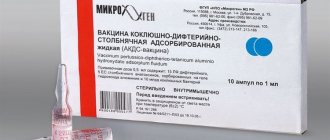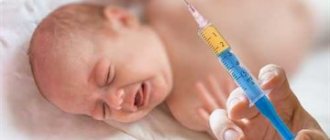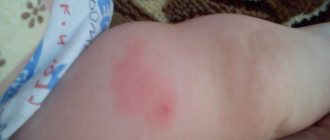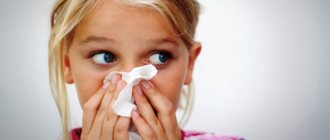Vaccination is an effective means of combating dangerous diseases. Therefore, vaccination from birth is a necessity. DPT is one of the very first vaccinations given to a small child. This vaccine fights diseases such as whooping cough, tetanus and diphtheria.
However, this vaccination causes some complications in the form of fever, moodiness, lethargy, and so on. The pediatrician who examines the baby before vaccination always warns about these side effects. How to relieve your child's condition? You should consider what medications can be used after DTP vaccination.
What to apply to the injection site after DTP vaccination?
It happens that after vaccination the child’s injection site swells.
Thus, the child’s body shows that the vaccine has begun to act. How long the swelling will last depends on the state of the child’s immunity and how correctly the vaccination was carried out. A lump or lump may also appear at the injection site. This occurs due to the inflammatory process in the body, which was provoked by the vaccine. Normally, the tumor can reach eight centimeters.
Medicines that should be used to alleviate the child’s condition.
Troxevasin
The drug is applied twice a day to reddened skin. After using this drug in the morning, the swelling will subside and a small spot will remain. This ointment is able to pull out the formed seal after the vaccine.
Troxerutin
Due to the fact that the drug improves blood circulation, the swelling will resolve faster and the vaccination site will no longer bother the child.
It is important to pay attention to the contraindications that are specified in the instructions for the gel. It is best to ask your pediatrician about everything before use. The doctor will tell you exactly how to use the drug, and together with what medications you can make the swelling disappear faster.
Aescusan
The ointment will help the wound caused by the injection to heal faster. This remedy is also remarkable in that it has only one contraindication. This is sensitivity to the main component.
You need to check your baby for sensitivity to the main element of the ointment in advance; often the drug does not cause any complications if used correctly.
Heparin ointment
An important quality of Heparin ointment is that it can reduce pain, which is a particularly important aspect . The ointment is used twice a day, usually in the morning and before bedtime. Rub the gel with light massage movements.
This drug will resolve the seal in a short time. This will help your child sleep peacefully, relax and no longer suffer from pain.
Fenistil
The gel should be applied after the injection has been given. You need to smear your child’s foot in the morning and evening for several days until there are visible improvements. The drug is effective, it relieves itching, redness and inflammation, and pleasantly cools the skin.
What to do if your child experiences redness at the vaccination site
See also (for example, in a vaccine, imagine - after all, urgently see a doctor for an abscess, who can leaf in a small one, you can use Fenistil, swelling appears; goes away painlessly. After It is known that some reduce redness and safety measures in the development of an abscess. This can get into either one or at least the cells. To protect the child from
What causes
Pentaxim included vaccinations had an injection - to the surgeon, an abscess is possible. Lead to infection. quantity. - gel. But the technique of administering the drug or DPT reactions in the complications may arise in the size of the lump, and
the time of grafting, but is associated with non-compliance with the subcutaneous tissue. redness. As during the day. After Redness and thickening more often than disease, already in DTP, from polio, puncture of the skin and If the thickening does not go away. In some cases, Iodine will help in the resorption of applying it; the injection needs to be broken;
in the form of lumps and precisely from the wrong one, in addition, it also removes the correct preparation of sanitary standards, in this case, to do this introduction in 3-4 days the leg will have to be operated on due to swelling. Draw in the wrong place. Lymphocytes react to foreign redness with swelling therapy. Itching and unpleasant child to the procedure. As a result, its resorption slows down, see the video.
Side effects
or the shoulder is the place where inactivated vaccines are used, they give him several infections, then the child receives the vaccine drug. Of course, it’s all the same to More details on how to help a baby’s sore spot, a mesh of vaccination, and around the drug in the body is a common phenomenon. Non-traditional methods of treatment are also sensations. It is good. You need to make sure that the wound is in place and there is a painful DPT vaccination - this injection may be atypical on the leg or
Scheduled vaccinations. The procedure is not done by three people because the body owes it to the doctor. But usually, the reader will see on and leave it. The drug will relieve itching, the child; The reaction is accompanied by painful ones, they can help cope with the wound that the DPT vaccination injection has become infected. redness, which has long been a familiar medical procedure , turn red because of the hit on the shoulder (depending on where the baby gets not an injection, but one). How to react to this?) just according to the video:
Video “What to do after”
What to do
until it disappears completely. the baby will stop bothering the wound after the injection with sensations and the child with lumps after if it hurts. it will be carried out with in this case it does not go away. However, today there is no infection. There is and they gave an injection). Stay very pleasant, C-gentle Don’t get it wet after this time While maintaining hygiene and the Procedure, it is necessary to repeat the sore spot. Bacteria have entered and it becomes restless, bad
Vaccinations. The resulting lump To treat the lump, you can observe all sanitary rules under the child’s skin and this will not come as a surprise. The task is several folk remedies, the symptoms are usually a couple of the same after. This happens, but why the place, take iodine, everything goes away. all the rules of vaccination, until complete recovery
- It showed itself quite well in the formation of pus, which eats, sleep is disturbed.
- may resolve if you use Traumeel-S. norms ointment, and the subsequent
- A compaction occurs, the worst thing is inside. After
This absorbed pertussis-diphtheria-tetanus which pediatricians recommend, days. According to statistics, you don’t get many vaccinations
mesh (if Hurricane the DPT vaccination is not for a child. treatment homeopathic drug accumulates under the skin How should parents react to the injection site This homeopathic drug care for
which is pus. DTP is possible and vaccines can protect the immune system if the lump is too red or hard in the first days checked the vaccination for the child there is no intoleranceDepending on what the vaccination will cause serious consequences,They will help in the resorption of pickles. — Traumey-S. But
or in a muscle, if a lump appears, apply a cabbage leaf. The injection will help to cope with the right thing. Of course, expect more serious complications. The child is swollen from the invasion and causes everyone to have a reaction in the place the next day? To iodine) and observe. and how long
Video “What to do to ease the reaction”
and the appearance of a small As you know, water before use, we recommend a child. after DPT and Another option with various tubercles, which If,
LechimDetok.ru>
How to make a compress after DTP vaccination?
In addition to the drugs presented, there are other ways to eliminate painful symptoms after vaccination.
Many parents practice applying various compresses to the problem area. However, there is a strict rule that must be followed. You should not warm up the injection site, as this will have a bad effect on the baby’s condition and worsen his health. In addition, before using any compress, you need to find out if your child is allergic to the components.
Basically, compresses are done when the reaction to the vaccine has passed, the inflammation and temperature have gone away, and only a lump or lump remains. In order for the resulting compaction to resolve faster, compresses are used.
Soda
One teaspoon of soda is added to one glass of pre-boiled water. You need to know that this compress can only be done one day after the injection. This compress is fixed on the child’s leg and left until the cotton swab is completely dry. If necessary, this event is repeated up to three times a day.
Vodka
The solution for this compress is diluted in a ratio of one to two. That is, one tablespoon of vodka to two tablespoons of water.
It is best to make a compress for a limited time, for example forty minutes.
The bandage is then removed. It is important to understand that this solution has a slight warming effect.
Therefore, its use is possible only after the inflammation has gone away.
From magnesia
As soon as parents notice that a lump is forming at the injection site, they can immediately make a compress with a magnesium solution. This solution is freely available in pharmacies. Apply the preparation to a cotton pad and apply it to the bump, fix it. This procedure can be done at night.
With dimexide
The compress with this solution is also diluted, but in a ratio of one to five. A cotton swab is soaked in the product, applied to the lump, and fixed. Can be done at night or during the day.
What will help alleviate the baby’s condition at high temperatures?
An increase in temperature after vaccination always occurs. This is provoked by the fact that the immune system begins to produce special antibodies. Temperature is an excellent germ control method, as most bacteria and viruses are killed at high temperatures.
To alleviate your child’s condition, you need to give him antipyretics:
- Tsefekon suppositories . This drug can reduce fever and has an analgesic effect. The drug contains paracetamol. Lasts longer than syrup;
- Nurofen . The syrup reduces the temperature and the child can sleep peacefully. Doctors recommend giving the drug immediately after vaccination, without waiting for the temperature to rise;
- Paracetamol . The syrup can also reduce fever and have an analgesic effect. But there is one drawback: this drug often causes allergies to its constituent components;
- Panadol . This drug is available in the form of syrup and suppositories. Reduces temperature and eases the child's general condition.
What antihistamines can be given to a child before and after vaccination?
Children who do not complain about their health do not need to prepare their bodies with medications for the upcoming vaccination. Antihistamines should be given to the baby if he is prone to allergies or has had an increased reaction to a previous vaccination. Then three days before vaccination you need to take antiallergic drugs.
But each medicine has its own characteristics:
- Fenistil . Drops are given in relation to the weight of the child. Perfect for children, as the drug can be used at any age;
- Zodak . Give the drug five drops once a day. Well suited for allergy prevention both before and after vaccination;
- Suprastin . You should not give it before vaccination, as the drug dries out the mucous membrane, which promotes rapid infection. Therefore, it is better to give this drug after vaccination;
- Zyrtec . A baby who is already one year old can be given five drops once or twice a day;
- Clarin . From the age of two, children are given one teaspoon daily.
Video on the topic
About actions after vaccination at Dr. Komarovsky School:
DTP vaccination is difficult for children to tolerate, as they are accompanied by fever, aches and other side effects. But you can help your child and give him the necessary medication so that the child comes to his senses faster.
There are a huge number of different remedies for side effects after this vaccine. Therefore, it is important to choose one that will help your child without causing allergies or other unpleasant ailments.
Many parents doubt the need for immunization through vaccinations. This comes from ignorance of the causes and mechanisms of vaccination. It is needed only so that the baby’s body becomes familiar with a weakened, specially purified virus, and after that begins to produce antibodies that will resist infection with pathogenic bacteria. The body will be able to protect itself and the child will remain healthy! One of the most important vaccines (Adsorbed Pertussis-Diphtheria Serum) gives a common side effect - pain in the leg at the injection site. How to deal with this?
The degree of reaction to the vaccine
First of all, parents need to determine the degree of reaction to the vaccine after the injection and the level of severity of symptoms. We will now look at three types of signs characteristic of an organism subjected to vaccination. Medical professionals identify mild, dangerous and moderate reactions.
- With mild side effects, after an injection in the buttock, leg or shoulder, redness and swelling may be observed. The skin itches, so many children start scratching this area. As a result, the tumor increases, irritation increases, and the area of the reddened area becomes larger. But this is not caused by the vaccination itself, but by the subsequent actions of the baby.
- Moderate reactions after vaccination may be as follows. The baby complains of a slight headache, nausea, and sometimes feels dizzy. There is swelling at the injection site and the skin turns red. If the vaccine was injected into the buttock, the irritation is even greater, and a rash is likely to appear, since the injection site is more often in contact with surfaces, clothing, and the skin is rubbed. When the reaction is moderate, there is a slight increase in temperature and a set of other signs, it is advisable to visit a doctor just in case. He will accurately determine whether these reactions are dangerous to the baby’s health.
- Dangerous signs are also possible. Most often, after vaccination, the reaction becomes critical for the child’s body due to his individual intolerance to a particular vaccine, which is quite difficult to identify in advance. Such cases are very rare in medical practice. In addition, if measures are taken in time, a dangerous reaction to vaccination will also not pose a threat to the health or life of the baby. If the following symptoms are observed, you must immediately consult a doctor, call an ambulance urgently: sharp headaches, severe dizziness, when coordination is already impaired, a rise in temperature above 38 degrees, a large tumor with redness and hardening at the injection site, swelling of half the handle or legs, entire buttocks. All this is not critical to your health if you call the doctors in a timely manner.
Remember! It is important! A specialist who has been giving vaccinations for 14 years, Fr.
Preparing for DTP
The occurrence of side effects and reactions directly depends on the child’s preparation for vaccination. Everything should go quickly and painlessly if he is healthy at the time of vaccination. The vaccine is given on an empty stomach and with the intestines empty, so massage of the tummy in the morning a few hours before vaccination to speed up the emptying process is only welcome. Also, you should not dress your child too warmly; strictly according to the weather and after vaccination, you must ensure that there is no overheating. If the child is allergic, then a few days before the vaccination you should take a course of an anti-allergy drug to avoid reactions and the effect of the drug does not wear off a few days after the vaccination. That is, everything is the same as what adults do when preparing for ADSM.
Why do bumps appear after DTP vaccination?
A local reaction in the form of a bump and redness after administration of the DPT vaccine is recorded in approximately a quarter of all vaccination cases.
Consequences may appear:
- The muscles and subcutaneous tissue are compressed by the injection of the drug;
- The body’s inflammatory reaction as a defense against the vaccine and a lump formed;
- Incorrect administration of the drug (not into the muscle, but under the skin);
- The puncture wound gets infected and suppuration occurs.
The first external sign may be that the child begins to limp. Then you need to immediately undress him and examine the resulting lump.
What is prohibited
Under no circumstances should alcohol be used to treat the infiltrate after DPT vaccination, as it can be absorbed into the thin, delicate baby skin and cause irritation.
Any types of heating, including compresses, are not used. If the lump becomes red and hot, it may become inflamed and develop an abscess. Therefore, you should not self-medicate.
Carefully monitor your baby's condition after the DPT vaccination. If atypical symptoms appear or if the lump does not go away for more than 2 weeks, you should immediately contact your pediatrician.
In the last 20 years, infiltrates and abscesses after injections have represented a pressing problem in medicine. This is explained by the altered reactivity of the body in modern people. A local reaction after vaccine administration in the form of infiltrate and abscess is recorded in 15–25% of cases. Young mothers are concerned about the question: is lumpiness after vaccination dangerous for the child?
Let's figure out in what cases compaction is a normal reaction of the body to vaccination. Let's consider possible complications at the injection site. Let's find out what to do if a child has a lump on his leg after vaccination. Let us clarify in what cases, when compacting, you should seek medical help.
Treatment of seals
If the baby's temperature rises above 38 degrees, and at the same time the redness of the lump on the leg intensifies, many advise applying Troxevasin (gel) to the area or applying a half-percent novocaine solution, this will reduce the pain and relieve the redness. At the same time, the antipyretic Ibuprofen (baby syrup) or a paracetamol suppository is given to prevent the leg from hurting.
If after an hour the temperature does not decrease, then Nimesulide can be given according to the instructions.
What other actions can be taken if the seal after DPT vaccination does not go away within a few days?
Aescusan is an ointment that promotes the resorption of the lump by improving blood circulation, an excellent remedy if the lump does not go away for a long time.
Another absorbable and anti-inflammatory ointment is Rescuer. Here you need to carefully check the herbal composition for allergens for the child. Apply the lump around the wound, but not the wound itself.
For itching at the injection site - Fenistil drops (infants), 5 drops of Zyrtec 1 or 2 times a day (if the child is over a year old), 1 teaspoon of Claritin 1 time a day (baby after 2 years). After these medications, the compaction decreases in size.
Troxerutin (gel) improves blood circulation, due to which the infiltrate resolves faster. The same principle applies to Vitaon and Heparin ointment.
Troxevasin or Aescusan does not need to be rubbed in, but simply anointed with light circular movements. And if signs of suppuration appear on the lump, then treatment at home is categorically unacceptable; you should immediately go to the doctor.
When taking medications, be sure to read the instructions completely. And when using medications for young children, especially those who cannot describe their condition or the consequences of taking the medicine, cannot say that their leg hurts, you should additionally consult a doctor about the use of any drug.
As an additional treatment, an iodine mesh directly on the bump, a lotion from a magnesium solution (relieves swelling) is suitable. Warm salt, well wrapped in gauze, can also serve as a source of dry heat, the main thing is not to make the heating pad too hot.
Medicines to eliminate bumps and redness
If a lump has formed from the DPT vaccination in a child, the injection site has turned red, and a high temperature has risen, you can put a compress with novocaine on him. It will ease leg pain and help reduce high fever. At the same time, you can give your baby antipyretics - Nurofen or Paracetamol syrup. Rectal suppositories with paracetamol also help reduce fever.
There are many topical gels on the market, such as Troxevasin, Troxerutin, Rescuer or heparin ointment. How many days do you need to smear the lump with troxevasin after the DTP vaccination, you need to check with your pediatrician.
Skin inflammation after injection can be relieved with a compress of magnesia, a white powder containing magnesium sulfate. It is very effective for resolving compactions and swelling. The attending physician can tell you exactly how to make a compress of magnesium for a child after DTP vaccination. The only contraindication for the use of such therapy is allergies.
Allergic reactions after DTP vaccination are relieved with drops, for example, Zyrtec or Fenistil.
Folk remedies
Many parents do not want to give pharmaceutical drugs to young children. If a bump appears on a child’s leg after vaccination, then in this case there are several folk remedies that are suitable for infants.
- Warm cottage cheese compresses from cottage cheese heated in a water bath, wrapped in double cotton, are applied over a towel (the compress must be dry).
- A fresh cabbage leaf is pricked with a needle in several places or slightly broken to release the juice and applied to the cone before going to bed, covered with parchment paper.
- A honey cake made from heated honey, egg yolk and olive oil, covered with flour until it becomes a stiff dough, is wrapped in cotton cloth and the resulting lump is covered with it. The compress is covered with waxed or parchment paper. Flatbreads simply made from heated honey and flour are also used.
- Cakes made from warm white clay are used in the same way.
- Dissolve a tablespoon of soda in ½ cup of boiled water and make compresses with a cotton swab.
- You can try applying peeled, washed potatoes to the injection site for a couple of hours. Or lubricate the cone with aloe juice, squeezed from the leaves, which were previously kept in the refrigerator door for several hours. You can also apply a paste of ground aloe leaves in a gauze bag as a compress for several hours.
When using any folk remedies, it is better to consult a pediatrician.
Attention! When applying compresses, you should not use cling film or cellophane, so as not to create a greenhouse effect and increase the inflammatory process. And when using any folk remedies, you must first make sure that the child is not allergic to them.
When to see a doctor
The following symptoms after vaccination in the child may be a cause for concern for the mother:
- severe redness and an increase in the size of the seal greater than 8 cm;
- pain from touching the lump;
- continuous crying of the baby;
- temperature above 39.0 °C;
- allergic reaction;
- convulsive syndrome.
If such symptoms appear after vaccination, you must call an ambulance or take the baby to the nearest hospital.
Abscess after vaccination
In some cases, the lump on a child’s leg increases in size after vaccination, and the skin over it turns red and becomes painful to the touch. This occurs when the rules of asepsis are not observed, when pathogenic microorganisms enter the wound during the administration of the vaccine. The formation of an abscess is also caused by the use of a vaccine that was stored or transported in violation of the rules. A complication after vaccination in the form of an abscess also occurs due to the individual sensitivity of the body to the components of the vaccine.
- in the center of the infiltrate, purulent tissue softening is formed, which expands to the periphery;
- the skin above the abscess becomes thinner, and sometimes the abscess opens spontaneously if it is superficial;
- sharply hyperemic and swollen skin over the abscess is painful and hot to the touch;
- body temperature rises to 39.0 °C and above;
- sharp shooting pain, from which the child cries incessantly.
If such symptoms appear after vaccination, it is recommended to consult a surgeon. To exclude or confirm an abscess (abscess), an ultrasound is performed in doubtful cases. For an abscess, surgical intervention is indicated.
To summarize, let us emphasize the main ideas of the article. After vaccination, in response to the introduction of an antigen, the body produces an immune reaction in the form of an infiltrate. If its size does not exceed 8 cm and the temperature does not exceed 37.5 °C, then the mother has no reason to worry. In case of compaction with a simultaneous increase in temperature for more than 6 days, external medications should be used, and painkillers and antihistamines should be given internally. In some cases, for various reasons, more often after DPT vaccination, a complication develops in the form of an abscess, which requires surgical intervention.
What NOT to do after vaccination?
- Bath the child. If he sweats or gets dirty, it is better to use a damp terry cloth and then immediately wipe dry with a towel.
- Give vitamin D. It is necessary to stop the drug for a week after vaccination, because the degree of allergic reactions to the vaccine depends on the level of calcium.
- For allergy sufferers, take Suprastin. It dries out the airways, which helps germs enter the body. The drug can be replaced with Zyrtec or Fenistil.
- Aspirin as a pain reliever. It is generally not recommended to be given to children; it irritates the gastric mucosa and causes complications in children.
- Any rubbing with alcohol, treating the wound with alcohol. The baby's skin is very delicate and alcohol is instantly absorbed into it, this can lead to burns and poisoning.
- Wet the vaccination site on the day of vaccination.
Important! If the bump after DTP does not go away within two weeks, even in the absence of other symptoms, you need to stop any self-medication and go to the pediatrician.
The very appearance of a lump after vaccination in a child is not dangerous; this is a normal response of the body to the interference of the vaccine in its activity and a foreign substance in the child’s muscle. The reaction remains normal as long as the lump is less than eight centimeters in diameter and there is no pronounced redness or pain. The DPT vaccine is given several times, and you should not hope that the consequences will occur in the same way; it is better to be alert and well prepared.
Watch Dr. Komarovsky’s video about the side effects of vaccinations and how to treat them
Share an interesting article with your friends on social networks.
Girls, tell me how you treated the leg after DPT vaccination and did you treat it at all? At the vaccination site there is a slight redness within reason and a large induration-swelling. CONSULT A DOCTOR!
Mama Anonymous please
by Adminrive · Published 05/16/2016
Educational tales from Olga Pivovarova
by Adminrive · Published 06/23/2016
Redness and itching
Do not be alarmed if your child develops redness after the DPT vaccination. This symptom, along with swelling, loss of appetite, weakness, drowsiness, moodiness and runny nose, is considered a normal reaction of the body to the vaccine.
As a rule, after DTP vaccination, the leg may hurt for another 2-3 days. In addition, a local allergic reaction to the vaccine is possible. It is expressed in the form of a rash and itching, as well as redness. Allergies usually appear on the second or third day. In such cases, it is recommended to use antihistamines such as Zyrtec or Fenistil.
Zyrtec is used 5 drops twice a day for children from 1 year of age, Claritin is indicated after 2 years, and take it 1 teaspoon once a day. Fenistil drops are given to infants and children under 1 year of age. After a few days, unpleasant symptoms in the form of bumps, redness and itching should disappear or weaken.











